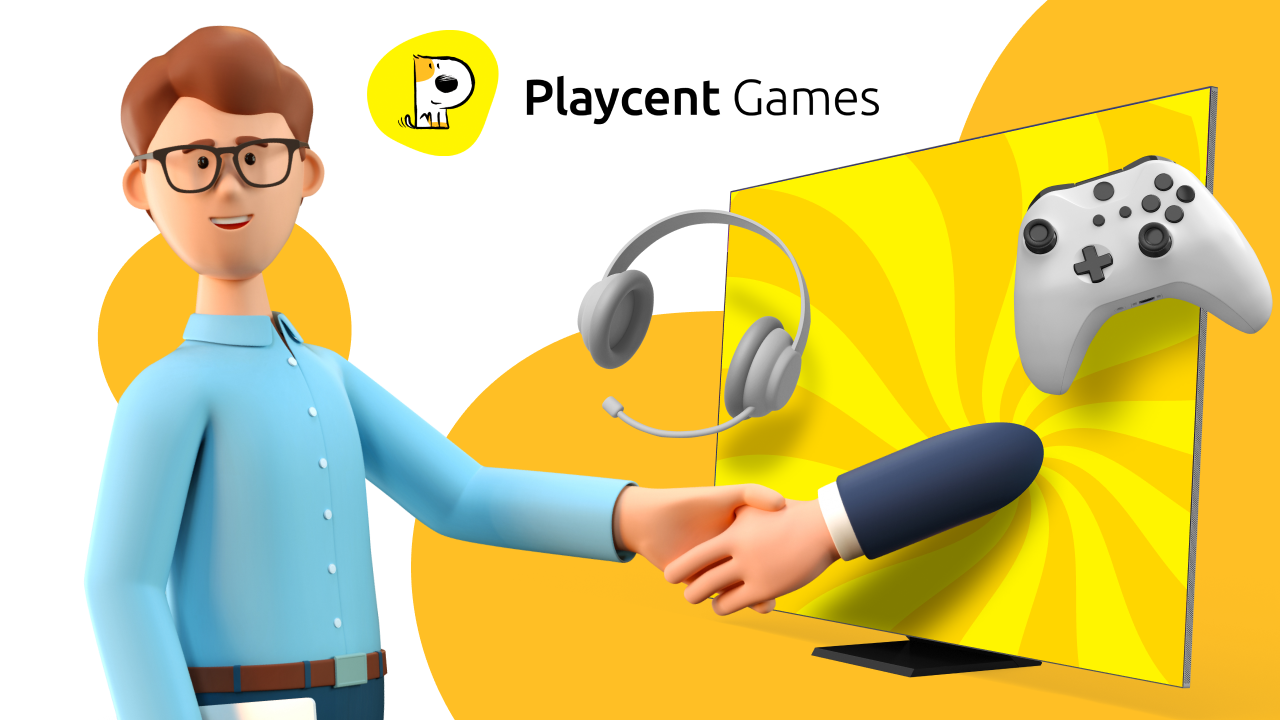Adapting Game Designs for CTV – How Game Developers Can Optimize UX/UI & More

In recent years, connected TV (CTV) has experienced a consistent surge in popularity, transforming content consumption and gaming practices. With an increasing number of gamers embracing the convenience of playing on expansive screens within the cozy confines of their living rooms, game developers are confronted with the task of recalibrating their design approaches. Once, the platforms for games, whether they were PC or consoles, were relatively similar for developers to work with. Now, they need to focus on delivering flawlessly integrated and captivating user experiences (UX) and user interfaces (UI) on CTV platforms.
Before the emergence of CTV, almost all games would be designed to fit screens of similar sizes, controlled by controllers of similar designs. CTV has turned this upside down, and while smart TVs are still the most popular medium for gaming, developers also have to think about smartphones, tablets, and more. This entails reimagining UI layouts, optimizing input mechanisms, and crafting visually engaging interfaces that seamlessly merge with the player’s surroundings.
In this article, we’ll delve into the realm of CTV game design, exploring the challenges developers face in more detail, how they can overcome the UX/UI difficulties, implement new controller designs, and discuss overall best practices that will boost their gaming development. By adapting their strategies and leveraging innovative techniques using this advice, developers aim to create enthralling and immersive experiences that captivate players.
There are numerous reasons to be excited about CTV gaming development, and it’s the perfect time to enter this dynamic market, so there’s no reason for developers to be hesitant. While there are challenges, there are far more opportunities to consider. Let’s start by examining some of the more prominent issues in more detail and why they’ve often put game developers off from creating content for CTV.
The State of the CTV Gaming Industry
One of the major problems faced by new CTV game developers are the specific limitations imposed by the major CTV platforms as almost all major market players have restrictions in place to accommodate low-capability devices. For instance, Roku, one of the most powerful CTV devices, possesses 2 GB of RAM—less than Apple TV but more than Amazon Fire TV. Contrast this with the 16GB of RAM offered by the Play Station 5 and the significantly higher rates of memory that are included as standard with gaming PCs.
Moreover, each platform has its own set of programming specifications, including the choice of programming language. As mentioned earlier, Roku necessitates familiarity with BrightScript, a unique language exclusive to the platform. While the language’s resemblance to JavaScript allows for the involvement of frontend developers proficient in JavaScript in the game development process, this still significantly limits development as the community that uses BrightScript is still small.
There’s also the fact that, erroneously, many game developers still see CTV as an emerging and risky market, believing that they would be better off focusing all their efforts on audience segments that have proven successes, such as PCs and consoles. There’s a natural logic to this position as the conventional gaming market is as strong as ever. However, the potential of CTV is huge, and its audience is increasing on a daily basis. In the U.S. alone, 80% of households have purchased a smart TV, and it is predicted that over 50% of households worldwide will own one by 2026, with further expansion anticipated in developing markets as well.
There are other issues to consider like controllers, which we’ll discuss in further detail later in this article. However, the key point at this stage is this: the challenges that game developers face when it comes to CTV are not insurmountable. Far from it, with the adoption of new best practices, it’s not difficult at all to create engaging game content. The first issue that should be addressed is UX/UI design as it’s the most immediately obvious factor to gamers and consumers.
Nine Key Issues For UX/UI
When it comes to optimizing user experience UX/UI for CTV games, developers need to apply tactics that differ from other formats. They need to focus more on simplifying navigation, ensuring intuitive layouts, and incorporating user-friendly features. By carefully considering these aspects, developers can create compelling and immersive gaming experiences.
To streamline UI for CTV navigation, there are several key considerations that you should focus on:
- Clear and Intuitive Layout: Design the UI with a layout that is both visually appealing and easy to navigate. This design should utilize visual cues, such as icons or labels, to distinguish different sections or categories, allowing users to quickly grasp the UI’s structure and navigate with ease.
- Minimalistic Design: You need to apply minimalism by creating an uncluttered UI by avoiding excessive text or visual elements. By utilizing ample whitespace, the UI becomes more readable, ensuring that users can focus on the essential elements without feeling overwhelmed
- Consistent Navigation Patterns: Establish consistency in navigation patterns across various screens and sections for a smoother user experience. You can employ standardized icons or menu structures that users can quickly learn and adapt to make this process easy to achieve.
- Streamlined Menus: You should opt for streamlined menus that minimize user effort. To achieve this you should avoid deep nested menus that require excessive scrolling or clicking. Instead, opt for drop-down menus, expandable sections, or collapsible panels.
- Search Functionality: Implement a search feature that allows users to swiftly locate specific content or games. It’s a good idea to incorporate predictive text or suggestions to assist users in their search queries as this will help to ensure they receive accurate answers.
- Voice Control Integration: Consider integrating voice control capabilities into the UI. By allowing users to navigate and interact with the interface using voice commands, the gaming experience becomes more convenient and accessible, particularly when using a remote control.
- Smart Recommendations: Make sure you use advanced algorithms and user preferences to offer personalized content or game recommendations. By analyzing user behavior and interests, the UI can suggest relevant options, reducing the time spent searching for desired content and enhancing the overall user experience.
- Onboarding and Tutorials: Include onboarding processes or tutorials within the UI to guide users through its various features and functionalities. This helps users can familiarize themselves with the interface and navigate it independently.
- Accessibility Features: Incorporate accessibility features into the UI design, catering to users with diverse needs. This may involve offering customizable text sizes, high contrast options, closed captioning, and other accessibility-enhancing elements that make the gaming experience inclusive and enjoyable for all.
By implementing these strategies, developers can simplify the UI for CTV navigation, delivering an intuitive, user-friendly, and accessible gaming experience that resonates with a wide range of users. By prioritizing clear design, streamlined navigation, and user-centric features, developers can unlock the full potential of CTV gaming, captivating and delighting audiences in the process.
Why It Pays to Be Simple
A major issue that game developers need to remember is that CTV devices have been predominantly designed for the consumption of television content, with minimal reliance on specialized input hardware such as gamepads or controllers. This aspect holds paramount significance for developers as it impacts the accessibility and potential enjoyment of new games by users. Notably, both Apple TV and Google TV lack dedicated gaming controllers, while Roku Ultra, at least, has versatile remotes that are compatible with numerous games and support customization.
That’s why developers need to consider creating games that can be used with relatively simple controllers, focusing on the essentials of gameplay and avoiding anything too complex. In fact, they should actively concentrate on developing games that can be played without the need for specific controllers or adapting existing gameplay mechanisms. Developers should also consider creating controllers designed specifically for CTV-based gaming, as there is a clear market gap in this area.
Visual Issues and Accessibility
It’s imperative for developers to focus on optimizing visuals for larger screens too, as games originally designed for compact displays may not seamlessly translate to the scale of CTV. It is recommended that you fine-tune your graphics and text sizes to ensure optimal visibility and a captivating user experience on these expansive screens. This will allow you to accommodate different CTV device aspect ratios, strategically adjusting elements to maintain a harmonious visual presentation.
Enhancing accessibility in CTV games is also extremely important, and developers need to recognize that their games must be inclusive to ensure they can be used by as broad an audience as possible. This is why they need to focus on successfully incorporating major accessibility features like closed captioning, subtitles, adjustable font sizes, and color contrast options. By incorporating these elements, developers empower individuals with diverse needs to fully engage with and enjoy their games, thereby meeting high professional and ethical standards while reaching a larger audience.
By approaching these considerations with a focused plan developers can create immersive and inclusive gaming experiences that resonate with the expanding audience of CTV users. None of these issues are insurmountable challenges that should discourage developers from creating CTV game content. In fact, by implementing the right best practices, it should be relatively simple for developers to enter this dynamic market.
The Key Best Practices You Need
The best practices you need are fairly straightforward and can be implemented by most game developers. Make sure you implement all three if you want to make it in the CTV industry, but don’t worry, they’re simple enough to understand and follow. We’ll start with the most immediately important, being user testing.
Conduct User Research and Testing
Gaining a deep understanding of the preferences and needs of CTV gamers is crucial for game developers so make sure you carry out thorough user research and testing. Through user research, you can identify patterns, preferences, and pain points, enabling you to make iterative design improvements. By also engaging with the CTV gaming community, developers can create games that resonate with their target audience, resulting in a more satisfying gaming experience.
A good example of how to conduct user research and testing is Crazino, a social casino app that’s won international recognition for its user-friendly UX design. That’s primarily thanks to its testing team, which uses the ‘split = AB test’ format, where two versions of the game (A and B) are compared to determine which performs better in terms of user experience. As a result, Crazino’s developers receive plenty of data from which they can provide a UX that meets consumer demand for high quality.
Utilize Data-Driven Insights and Analytics
The power of data cannot be underestimated so make sure you leverage analytics and data-driven insights to gain valuable information about user engagement and behavior. This provides a comprehensive understanding of how players interact with your game, enabling developers to optimize UX/UI. By identifying areas of improvement through data analysis, you can make informed design decisions that enhance the overall gaming experience.
Collaborate with CTV Platform Developers
Successful game development requires close collaboration with CTV platform developers so make sure you familiarize yourself with platform-specific guidelines and constraints to ensure your games adhere to each platform’s standards. This collaboration opens doors to unlock additional capabilities and leverage platform features that enhance the UX/UI. By working hand-in-hand with CTV platform developers, game developers can optimize their games for seamless integration, making future development exponentially more effective.
The Takeaway
The time is right to become a major player in the CTV gaming market as audiences continue to grow and demand increases in tandem, it’s an exciting time to join this exciting market. As we’ve covered above there’s no reason to view the CTV gaming market as risky or novel, and soon it will be as well known and accepted as mobile games are. Remember when that market was in its infancy and it was viewed as a risk?
Not anymore, so make sure you take advantage of the opportunity in front of you and start to develop gaming content for CTV. All you need to do is follow the concepts outlined in this article and you’ll be set for success; Make changes to your usual UX/UI development programs, consider controller limitations and whether you can create new styles, and consider visual and accessibility issues too. Finally, remember our three best practices, and whatever content you create will likely prove to be a success.






